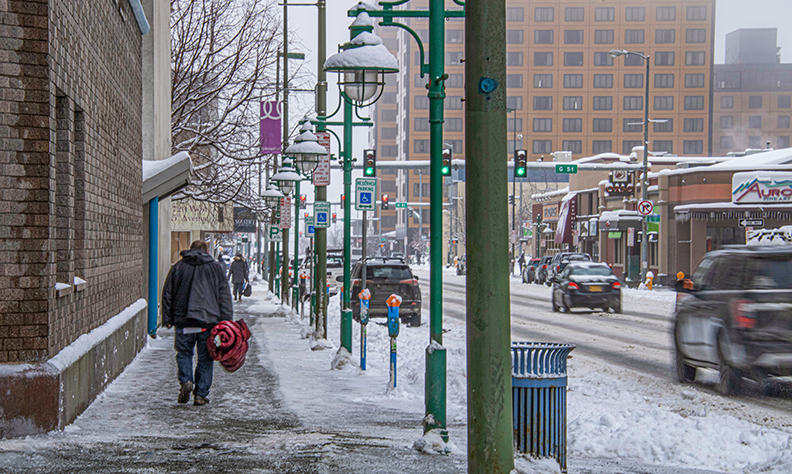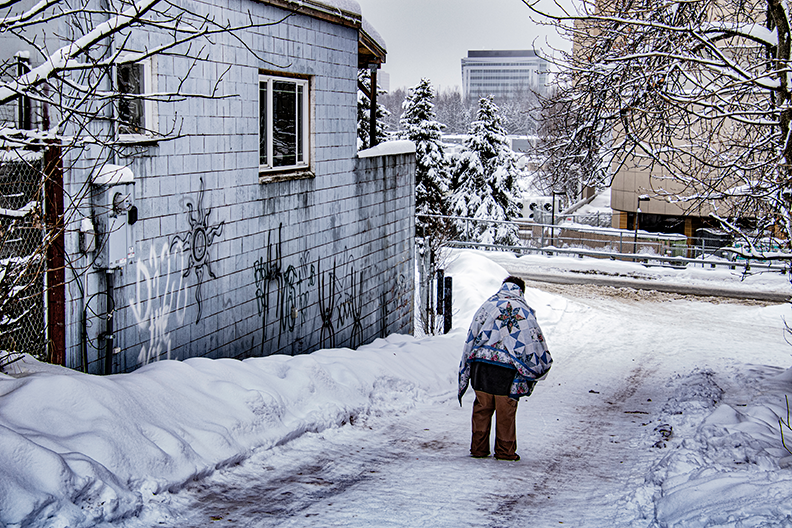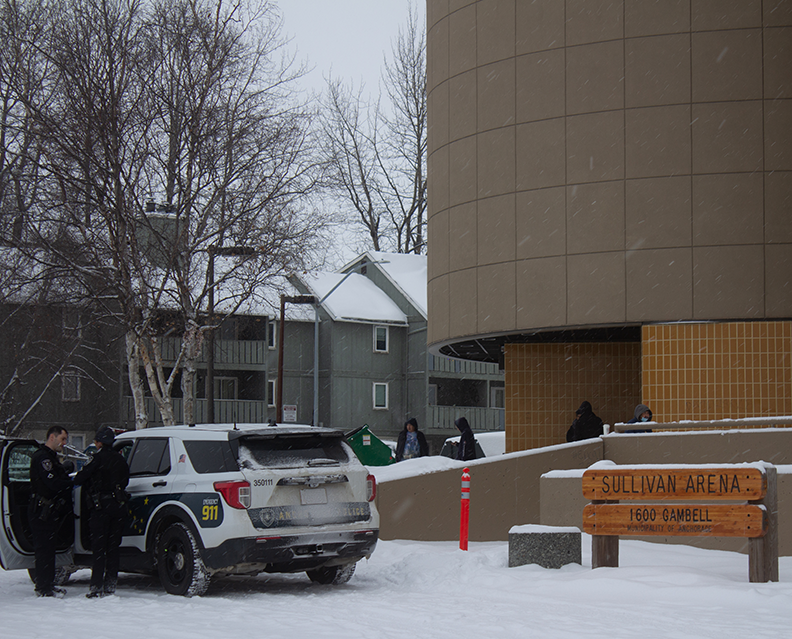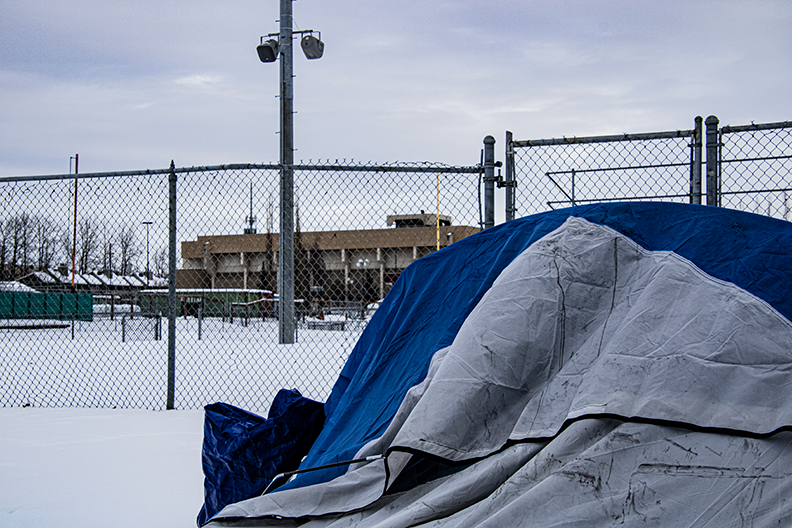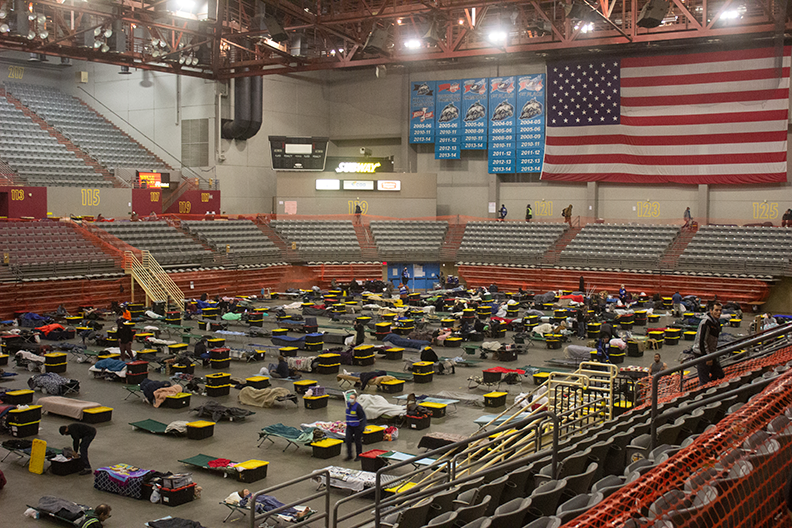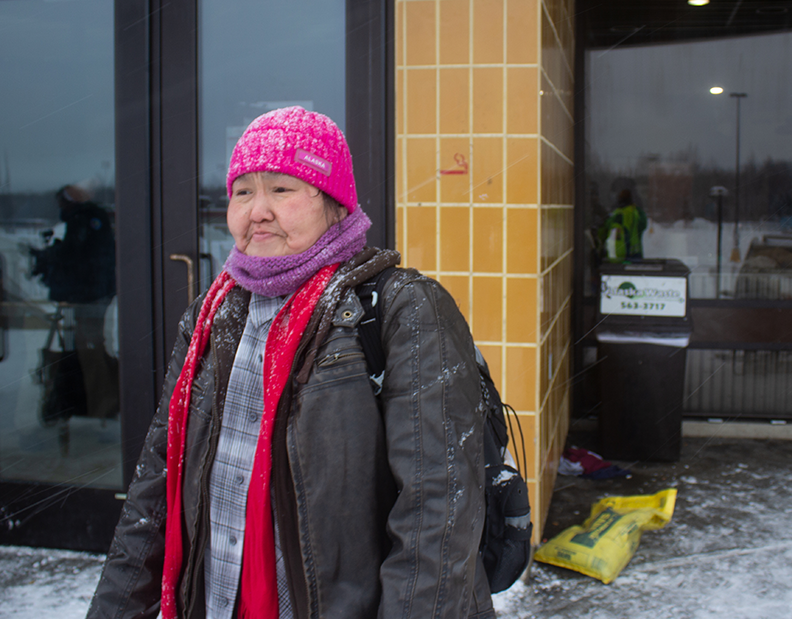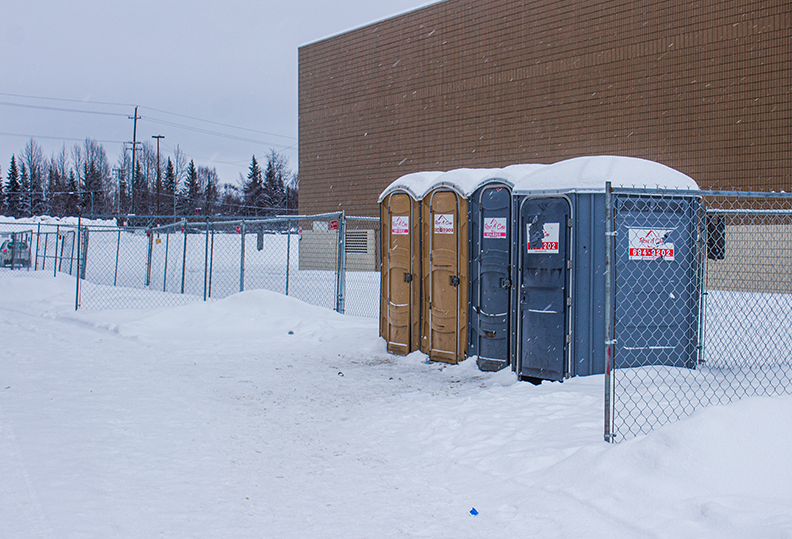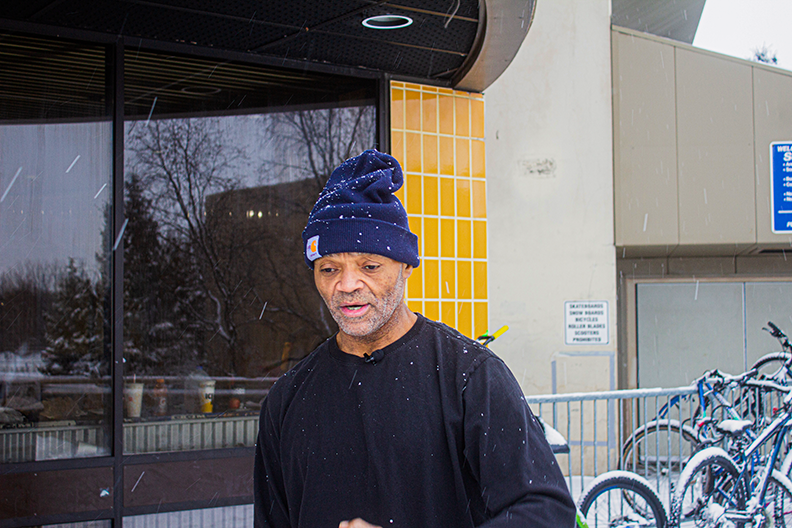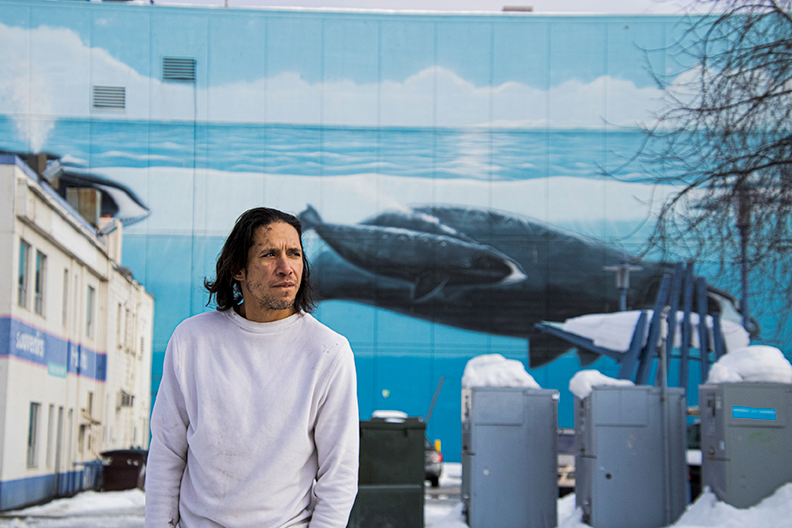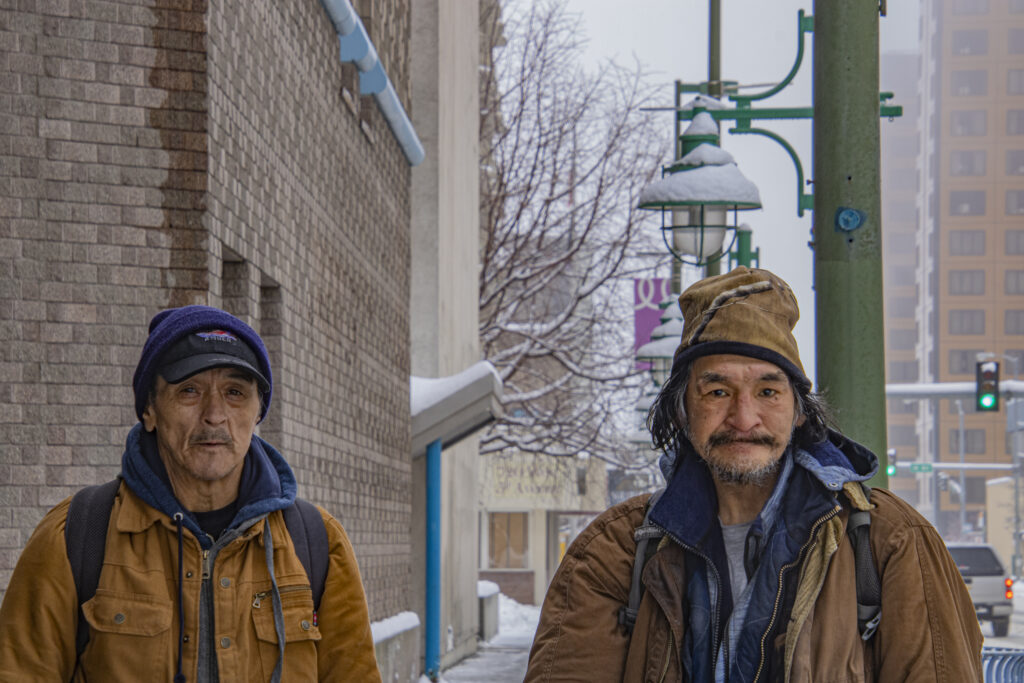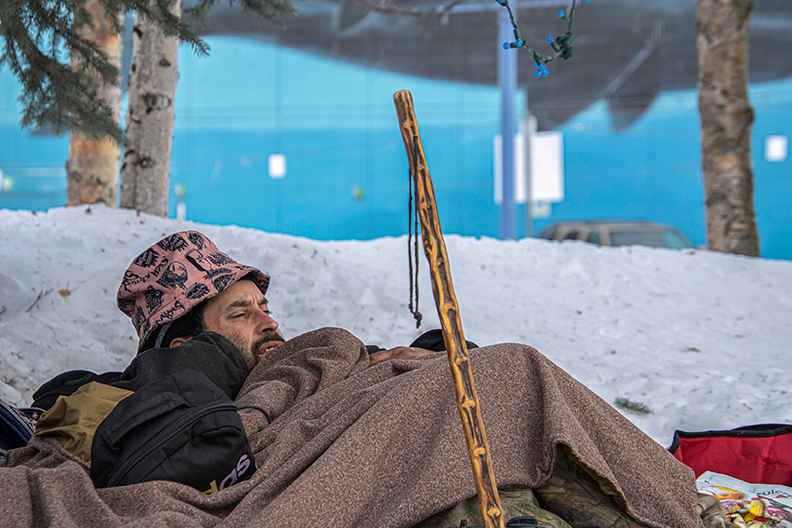Anchorage municipality pursues solution to replace Sullivan Arena for housing hundreds
Photos by Lucas Wright and Naomi Stock
Alaska is a difficult place to be homeless. Seven months out of the year have average low temperatures that dip below freezing. Escaping to warmer climates requires a plane ticket or a passport and approximately 2,000 miles of driving.
To be homeless in a place like Anchorage is not like being homeless in a place like Venice Beach, California.
This is not a story about why people are homeless, or whether or not they are at fault. This is a story about people in Anchorage who are in a vulnerable place, and about the successes and failures of this community to protect and support them.
This is a story about people like Vern, who is a 51 year old softspoken Native Alaska man. He moved from Bethel, where he was born and raised, to Wasilla in 1999 after a stint in prison, and then to Anchorage sometime after. He lived in Wasilla in his car for some time later on, trying to find a way back home to Bethel. One winter, he said, he slept under a spruce tree near the funeral home in Spenard.
“One day, I woke up and someone had put a blanket over me.” It touched his heart, he said, to see how kind people were.
Vern has two daughters and a son, and a ten-year-old grandson. He’s feeling old these days, spending his nights on a cot in the Sullivan Arena.
The country’s largest homeless shelter
Nearly 500 people are sleeping in the Sullivan Arena per night. The building, once a site reserved for sports and concerts, is now Anchorage’s mass homeless shelter. Hundreds of cots dot the arena, while more people sleep on the floor. When the city opened this shelter in 2020, at the onset of the coronavirus pandemic, it became the largest homeless shelter in the nation. Since that time, the Sullivan Arena has been subject to change by two mayors, two operators, and at least four directors.
When Dave Bronson was running for mayor going into 2021, addressing homelessness was a pillar of his campaign. In the months following his inauguration, the city ended its contract with nonprofit Bean’s Cafe to operate the mass shelter. A new operator, the for-profit company 99 Plus 1, stepped into their place.
99 Plus 1, a relatively unknown company, took over the mass shelter contract in September 2021. In the six months following, 99 Plus 1 has had three different directors, each with their own vision and goals for the shelter.
As of March 2022, Cesar Ramirez de la Cruz is the director of the Sullivan Arena for 99 Plus 1. He was promoted from assistant director in early December when Shawn Hays resigned. Hays had previously been the head of mass care at the shelter for the municipality of Anchorage, until she was fired in October 2021.
The city has also struggled to find a permanent homelessness coordinator. John Morris, who was the homelessness coordinator for the previous administration, resigned near the end of October last year, around the same time Hays was fired. Bob Doehl, who was in charge of operations at the Sullivan Arena, also resigned at that time. Since then, there have been two Human Services division managers in charge of the homelessness response: Nicole Lebo, who was fired in November, and Dave D’Amato, who resigned in late February.
Municipality of Anchorage Realtime Shelter Occupancy Dashboard
Making changes
Before his resignation, D’Amato seemed proud of the changes he had brought to the Sullivan Arena, citing the “safety and security” of the clients and the surrounding community above all else. Under his management, several fences had gone up around the shelter and in surrounding areas to control the flow of people and contraband into the building. The city also started winter camp abatements for the very first time, clearing out 15 camps in the area, according to D’Amato. There were also a lot of changes made inside the building, especially regarding male and female mixing areas. The demarcations between these areas became more obvious, with actual barriers installed.
“This is primarily around keeping women safe, which is a huge priority for the mayor,” D’Amato said.
Other changes included adding more beds after consulting with the Centers for Disease Control and Prevention and emergency services. In late December, the city reorganized the shelter to add capacity for about 100 more clients.
Then, they started clearing out homeless camps in the area. The city is required by law to have open space at shelters when doing these camp abatements.
Loila Joyce Ahkiviana, who goes by Mama Joyce, has been staying at the Sullivan Arena for about two years now. She says that there have been a lot of improvements in the shelter, especially regarding cleanliness and behavior.
“I prayed for cleaning up because when I first walked in these doors… there were sex, drugs, alcohol, everything and it was unbearable, the stinkiness of it, the stench of it.”
The Sullivan Arena bathrooms have not been functional since the first couple months of shelter operations. There are no plans to repair the flushing toilets at this time.
A plan to close the shelter
“Pretty quickly what happened is that [the Sullivan Arena toilets] became inoperable and so we went to a system where we’re using port-a-potties,” said D’Amato. “We have figured out that that is the best facility that we could provide for the people here.”
Another resident, Chris Marrease Jenkins, who has been in and out of the shelter throughout the course of the pandemic, has spent about four or five months cumulatively as a resident at the Sullivan Arena. Jenkins is worried about the city’s plan to close the shelter by June.
“In all honesty, though society may not [see] it, this place is a necessity. Everyone comes to a point in life where you have nothing and nowhere to go and no one to help you. A place like this is a need.”
Jenkins feels like he is prepared to support himself once the mass shelter closes, but he is worried about his fellow residents.
“If there’s not something set up, established to help those who mentally, emotionally and psychologically don’t have it in them to help themselves then they’ll live off society any way they have to, and [they’re] gonna be… more of a burden to society than [they are] right now.”
Jenkins worries that his fellow residents may turn to crime in order to survive if they are abandoned to the streets, but the current administration is more optimistic.
“The mayor’s perspective, our perspective is the safety and security of this community is job one, and we have no intention of creating conditions that would lead to a public health or a safety and security crisis,” said D’Amato. “The transition is being worked on, there’s some very thoughtful people on it, we’re optimistic that we’ll come up with some good stuff.”
The plan to close the shelter is based on sending clients from the Sullivan Arena to one of five other smaller shelters and programs managed by the municipality and Anchorage-based non-profit organizations.
Cathleen McLaughlin has been working in and around homelessness in Anchorage since 2012, including managing the Sullivan Arena mass shelter for both Bean’s Cafe and the municipality before 99 Plus One became involved. She is also worried about the city’s plan to close the mass shelter.
“It won’t be able to be implemented this spring in a way that will replace the Sullivan,” said McLaughlin.
When the shelter closes, the Barratt Inn would be used to house people long-term who are ready to work and the Sockeye Inn would be used for medically fragile people. There would be a Salvation Army substance-abuse shelter, another shelter for unique populations, and a 200-person navigation center on Tudor Rd. The navigation center would be a place where non-profits could come and provide resources to people who are homeless.
Navigational centers like the one the city is planning have been implemented in Anchorage and across the country to varying degrees of success in the past.
“The way they succeed is you partner with the client and you follow them out and you continue to partner with them even after they’ve left the navigation center. It fails if you just give somebody a bus voucher and just say, ‘good luck to you’,” said McLaughlin.
McLaughlin wants to see organizations working together toward a common goal. She is worried that personal agendas will stall progress toward helping people become stably housed. The constant changing of directors, managers, and operators also means that priorities and methods are constantly changing within the city’s homelessness response.
The most important work to be done for the homeless community right now, McLaughlin said, is to provide stability. “No matter where you go, people need to get out of survival mode, they need to get into stabilization, and they need to get into a sustainable path.”

